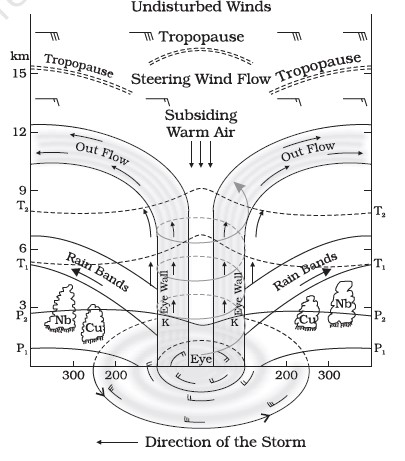-
26 Jan 2024
GS Paper 1
Geography
Day 59: What are the conducive conditions for the genesis and strengthening of tropical storms? Explain the characteristics of a mature tropical cyclone using a schematic representation. (250 words)
- Start the answer with a discussion that sets a context for the question.
- Discuss the conducive conditions for the genesis and strengthening of tropical storms.
- Explain the characteristics of a mature tropical cyclone using schematics.
- Conclude suitably.
Introduction
Tropical cyclones are powerful and destructive weather systems characterized by low-pressure centers, high winds, and heavy rainfall. These storms are also known as hurricanes in the Atlantic and Northeastern Pacific, typhoons in the northwestern Pacific, and cyclones in the South Pacific and Indian Ocean.
Body
Conducive Conditions for Genesis:
- Warm Ocean Waters:
- Tropical storms form over warm ocean waters with a temperature of at least 26.5 degrees Celsius.
- This warmth provides the necessary energy to fuel the storm's development.
- Coriolis Effect:
- The Coriolis effect, caused by the Earth's rotation, is essential for the spin of a tropical cyclone.
- Storms cannot form directly on the equator due to the absence of this effect.
- The Coriolis force imparts the necessary rotation to initiate and sustain the storm.
- Low Vertical Wind Shear:
- Vertical wind shear refers to the change in wind speed and direction with altitude.
- Low vertical wind shear is conducive for tropical cyclones as high shear can disrupt their vertical development.
- It allows the storm to maintain its organization and intensify.
- Atmospheric Instability:
- A conducive atmosphere for tropical storm genesis involves high levels of atmospheric instability.
- Warm, moist air rising from the ocean surface creates instability, leading to the development of towering clouds and thunderstorms.
Strengthening of Tropical Storms:
- Warm Ocean Water Sustenance:
- The warm water provides latent heat, which is crucial for the storm's energy.
- Areas with deep warm water are more likely to sustain and strengthen tropical cyclones.
- Eyewall Formation:
- It is a ring of intense thunderstorms surrounding the eye, where the strongest winds and heaviest rainfall occur.
- The development and persistence of a well-defined eyewall signify the maturity of the cyclone.
Characteristics of a Mature Tropical Cyclone:
- High Wind Speeds:
- Mature tropical cyclones are characterized by high wind speeds, often exceeding 119 km per hour.
- The strongest winds are typically found near the center of the storm in the eyewall.
- Heavy Rainfall:
- Intense rainfall is a hallmark of mature tropical cyclones. The combination of warm, moist air and powerful updrafts within the storm system leads to heavy precipitation, causing flooding in affected areas.
- Storm Surge:
- A mature tropical cyclone can generate a storm surge, a rapid rise in sea level along the coast.
- This surge, combined with high waves, can lead to devastating coastal flooding, making storm surge one of the most dangerous aspects of these storms.
- Long Lifespan:
- Mature tropical cyclones can have a relatively long lifespan, lasting for days or even weeks.
- Their ability to maintain strength over extended periods poses significant challenges for disaster preparedness and response.
Conclusion
Understanding the conducive conditions for the genesis and strengthening of tropical storms, as well as the characteristics of mature tropical cyclones, is essential for effective disaster management and preparedness. Governments must utilize this knowledge to enhance their resilience and response strategies.





